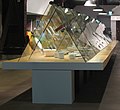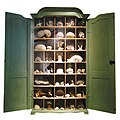Portal:Museums
The Museums Portal
A museum (/mjuːˈziːəm/ mew-ZEE-əm) is an institution dedicated to displaying and/or preserving culturally or scientifically significant objects. Many museums have exhibitions of these objects on public display, and some have private collections that are used by researchers and specialists. Compared to a library, a museum hosts a much wider range of objects and usually focus around a specific theme such as the arts, science, natural history, local history, and other topics. Public museums that host exhibitions and interactive demonstrations are often considered to be tourist attractions, and many museums attract large numbers of visitors from outside their host country, with the most visited museums in the world regularly attracting millions of visitors annually.
Since the establishment of the earliest known museum in ancient times, museums have been associated with academia and the preservation of rare items. Museums originated as private collections of interesting items, and not until much later did the emphasis on educating the public take root. (Full article...)
Selected museum
The National Museum of Korea (Korean: 국립중앙박물관) is the flagship museum of Korean history and art in South Korea. Since its establishment in 1945, the museum has been committed to various studies and research activities in the fields of archaeology, history, and art, continuously developing a variety of exhibitions and education programs.
It was relocated to the Yongsan District in Seoul in 2005. On June 24, 2021, the National Museum of Korea opened a new branch inside Incheon International Airport. Located in the boarding area of the airport in front of Gate No.22, the branch was opened in celebration of the museum's 20th anniversary. (Full article...)
Selected interior image
Selected general article

In conservation, library and archival science, preservation is a set of preventive conservation activities aimed at prolonging the life of a record, book, or object while making as few changes as possible. Preservation activities vary widely and may include monitoring the condition of items, maintaining the temperature and humidity in collection storage areas, writing a plan in case of emergencies, digitizing items, writing relevant metadata, and increasing accessibility. Preservation, in this definition, is practiced in a library or an archive by a conservator, librarian, archivist, or other professional when they perceive a collection or record is in need of maintenance.
Preservation should be distinguished from interventive conservation and restoration, which refers to the treatment and repair of individual items to slow the process of decay, or restore them to a usable state. "Preventive conservation" is used interchangeably with "preservation". (Full article...)
Did you know...
- ... that a teenage boy stole over US$300,000 worth of paintings from the Deshong Art Museum by simply taking them off the wall and sliding them through a window?
- ... that the Lemmon Petrified Wood Park & Museum contains 3,200 tons of petrified wood?
- ... that the Felix M. Warburg House was converted into the Jewish Museum after nearly being replaced by apartments?
- ... that Saint Rose Catholic Church was moved from the ghost town of Fleetwood, Oregon, to the Fort Rock Valley Historical Homestead Museum in 1988?
- ... that for fifteen years Joseph Henry Gest was both the director of the Cincinnati Art Museum and the president of the Rookwood Pottery Company, spending mornings at one and afternoons at the other?
- ... that the Museum of Contemporary Art Australia is the only contemporary art museum in the country with a permanent collection?
Get involved
For editor resources and to collaborate with other editors on improving Wikipedia's Museums-related articles, see WikiProject Museums.
Selected exterior image
Selected type of museum

Cabinets of curiosities (German: Kunstkammer and Kunstkabinett), also known as wonder-rooms (German: Wunderkammer), were encyclopedic collections of objects whose categorical boundaries were, in Renaissance Europe, yet to be defined. Although more rudimentary collections had preceded them, the classic cabinets of curiosities emerged in the sixteenth century. The term cabinet originally described a room rather than a piece of furniture. Modern terminology would categorize the objects included as belonging to natural history (sometimes faked), geology, ethnography, archaeology, religious or historical relics, works of art (including cabinet paintings), and antiquities. In addition to the most famous and best documented cabinets of rulers and aristocrats, members of the merchant class and early practitioners of science in Europe formed collections that were precursors to museums.
Cabinets of curiosities served not only as collections to reflect the particular curiosities of their curators but also as social devices to establish and uphold rank in society. There are said to be two main types of cabinets. As R. J. W. Evans notes, there could be "the princely cabinet, serving a largely representational function, and dominated by aesthetic concerns and a marked predilection for the exotic," or the less grandiose, "the more modest collection of the humanist scholar or virtuoso, which served more practical and scientific purposes." Evans goes on to explain that "no clear distinction existed between the two categories: all collecting was marked by curiosity, shading into credulity, and by some sort of universal underlying design". (Full article...)
In the news
- 31 May 2024 – Israel–Hamas war protests
- Pro-Palestinian protesters occupy parts of the Brooklyn Museum in New York City, New York, U.S. (Reuters)
- 12 May 2024 –
- Forty-nine Vatican Museums employees start an unprecedented labor dispute over unfair and poor working conditions against the Vatican's Pontifical Commission. (Reuters)
- 6 May 2024 –
- The 2024 Met Gala takes place at the Metropolitan Museum of Art in New York City with the theme "The Garden of Time", celebrating the Met's exhibit Sleeping Beauties: Reawakening Fashion. (Vanity Fair)
Subcategories
Subtopics
Lists
- Museums
- Most visited museums (by region)
- Art museums: most visited, largest
Types
- Art museum
- Agricultural museum
- Archaeology museum
- Architecture museum
- Artillery museum
- Aviation museum
- Biographical museum
- Cabinet of curiosities
- Ceramics museum
- Children's museum
- Community museum
- Computer museum
- Design museum
- Dime museum
- Ecomuseum
- Economuseum
- Ethnographic village
- Farm museum
- Fashion museum
- Folk museum
- Food museum
- Green museum
- Hair museum
- Hall of Memory
- Heritage centre
- Historic house museum
- Human rights museum
- Imaginarium
- Interpretation centre
- Jewish museum
- Lapidarium
- Lighthouse museum
- Living museum
- Local museum
- Maritime museum
- Migration museum
- Mobile museum
- Museum ship
- National history museum
- Natural history museum
- Open-air museum
- Palace museum
- Postal museum
- Prefectural museum
- Print room
- Private museum
- Regimental museum
- Schatzkammer
- Science fiction libraries and museums
- Science museum
- Sex museum
- Sculpture garden
- Technology museum
- Textile museum
- Torture museum
- Toy museum
- Transport museum (list)
- University museum
- Virtual museum
- Wax museum
- Writer's home
Related
Associated Wikimedia
The following Wikimedia Foundation sister projects provide more on this subject:
-
Commons
Free media repository -
Wikibooks
Free textbooks and manuals -
Wikidata
Free knowledge base -
Wikinews
Free-content news -
Wikiquote
Collection of quotations -
Wikisource
Free-content library -
Wikiversity
Free learning tools -
Wiktionary
Dictionary and thesaurus







































































